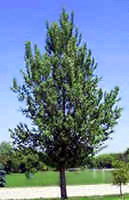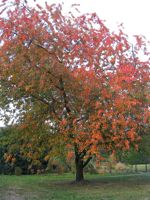Mon-Fri 9am - 5pm Mountain time
Hill Poplar vs Black Cherry
Populus x Hill
Prunus serotina
CUSTOM GROW
NOT AVAILABLE THIS SEASON - MIGHT RETURN
Hill Poplar is a hardy, fast-growing tree with a narrow crown. Hill Poplars function well as a privacy screen or windbreak.
This attractive, long-lived shade tree is a great choice for home and commercial consumers alike, as it requires little pruning or maintenance care.
Hill Poplar has largely been replaced by more desirable hybrid poplar varieties that are more resistant to disease.
Black Cherry is common in eastern North America but a rare find elsewhere. This tree is shade tolerant and is often found in old fields, forest openings, and along fencerows.
The fruit is edible and is commonly used to flavor rum and brandy. It is also edible and often eaten fresh or used in wine or jelly. Black Cherry trees typically begin producing fruit when they are 10 years of age.
Black Cherry wood is a rich reddish-brown color and is strong, making it valued in cabinetry and woodworking. It is often used in reclamation as well.
The leaves can poison livestock as they contain cyanide derivatives and precursors. However, many have noted that deer still seem to browse their trees with impunity and birds and other animals eat the fruit when available.
Hill Poplar Quick Facts
Black Cherry Quick Facts
Toxicity: bark and wilted leaves toxic to livestock
In row spacing: 2.4 m (8 ft)

